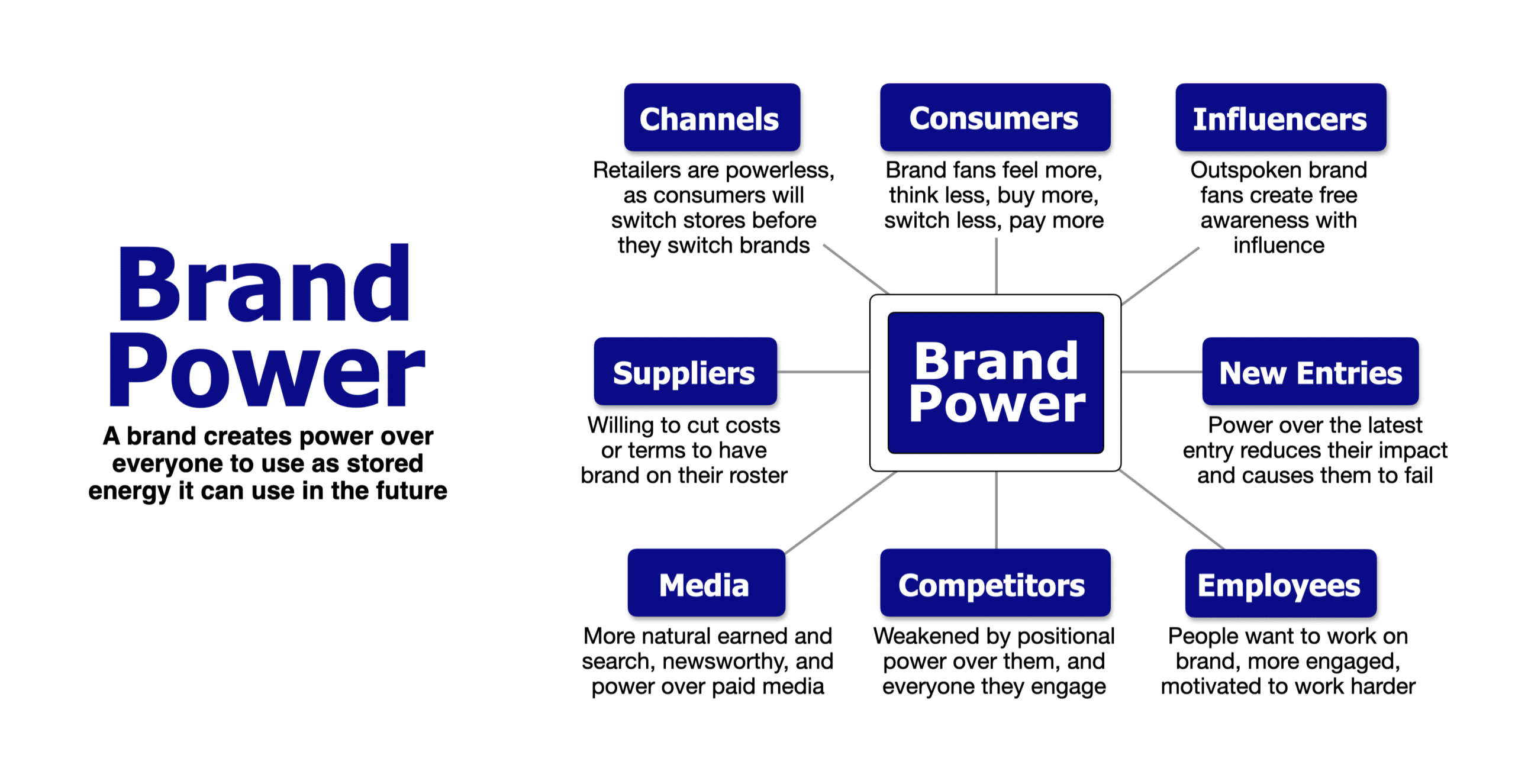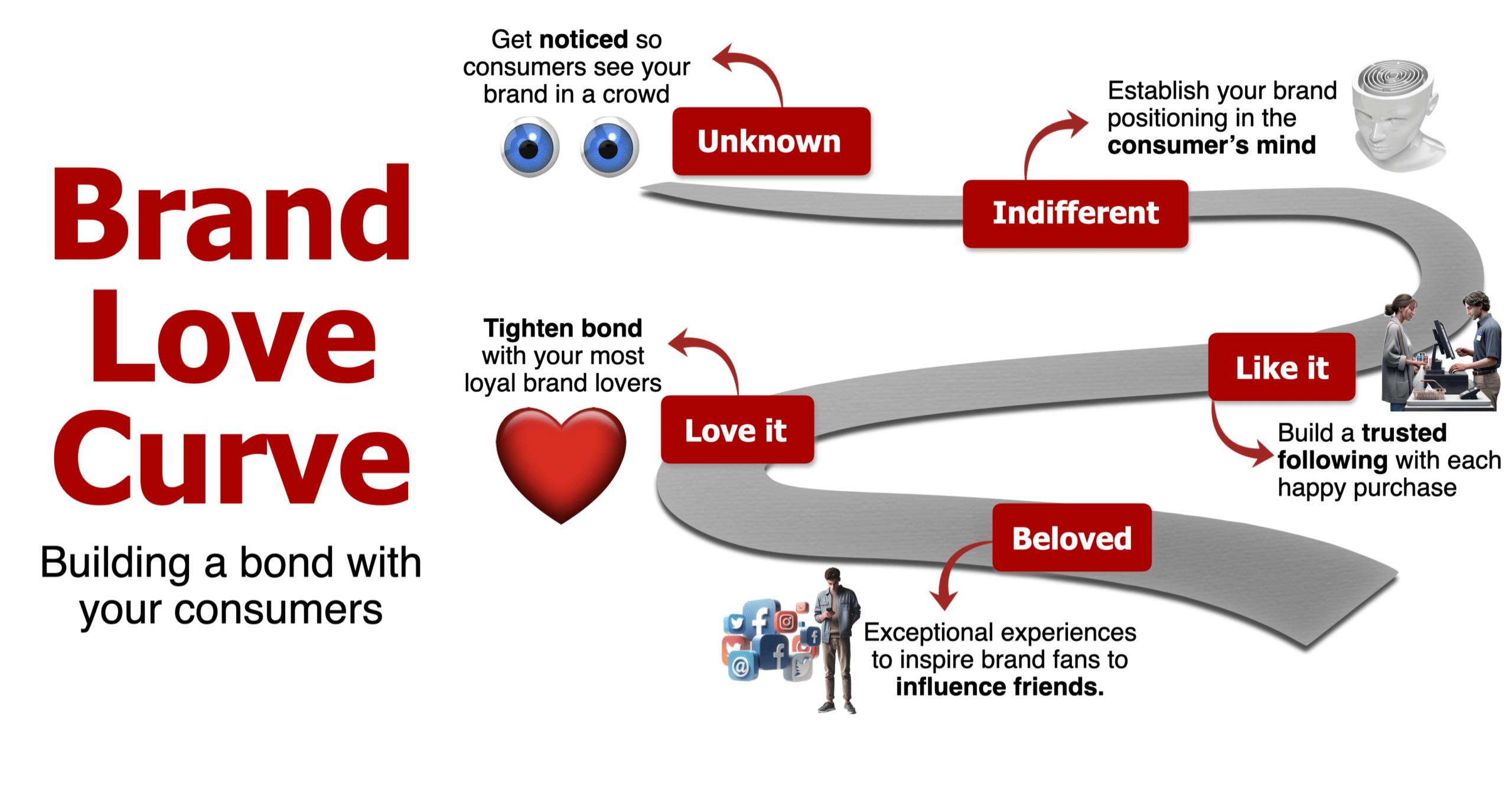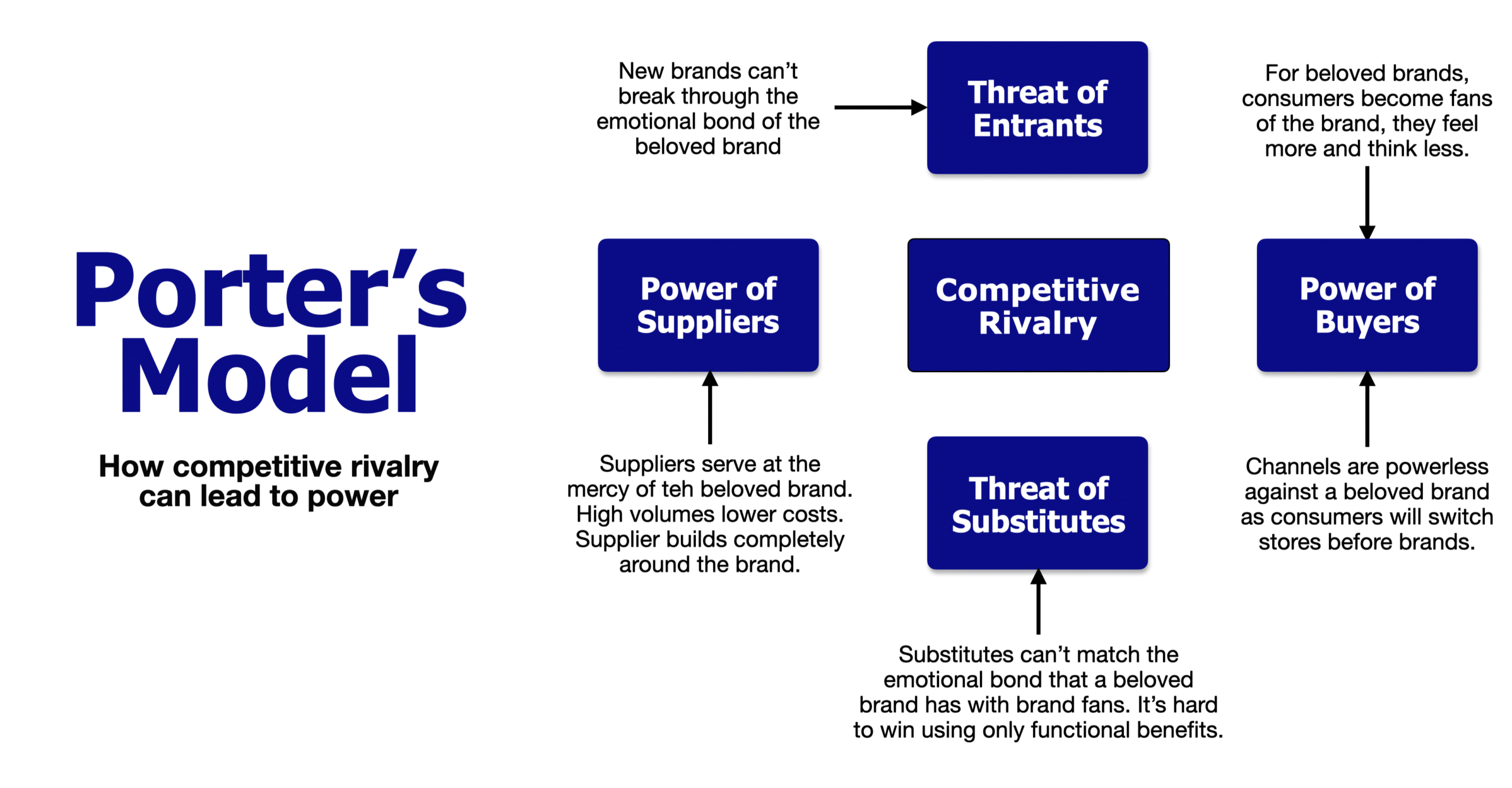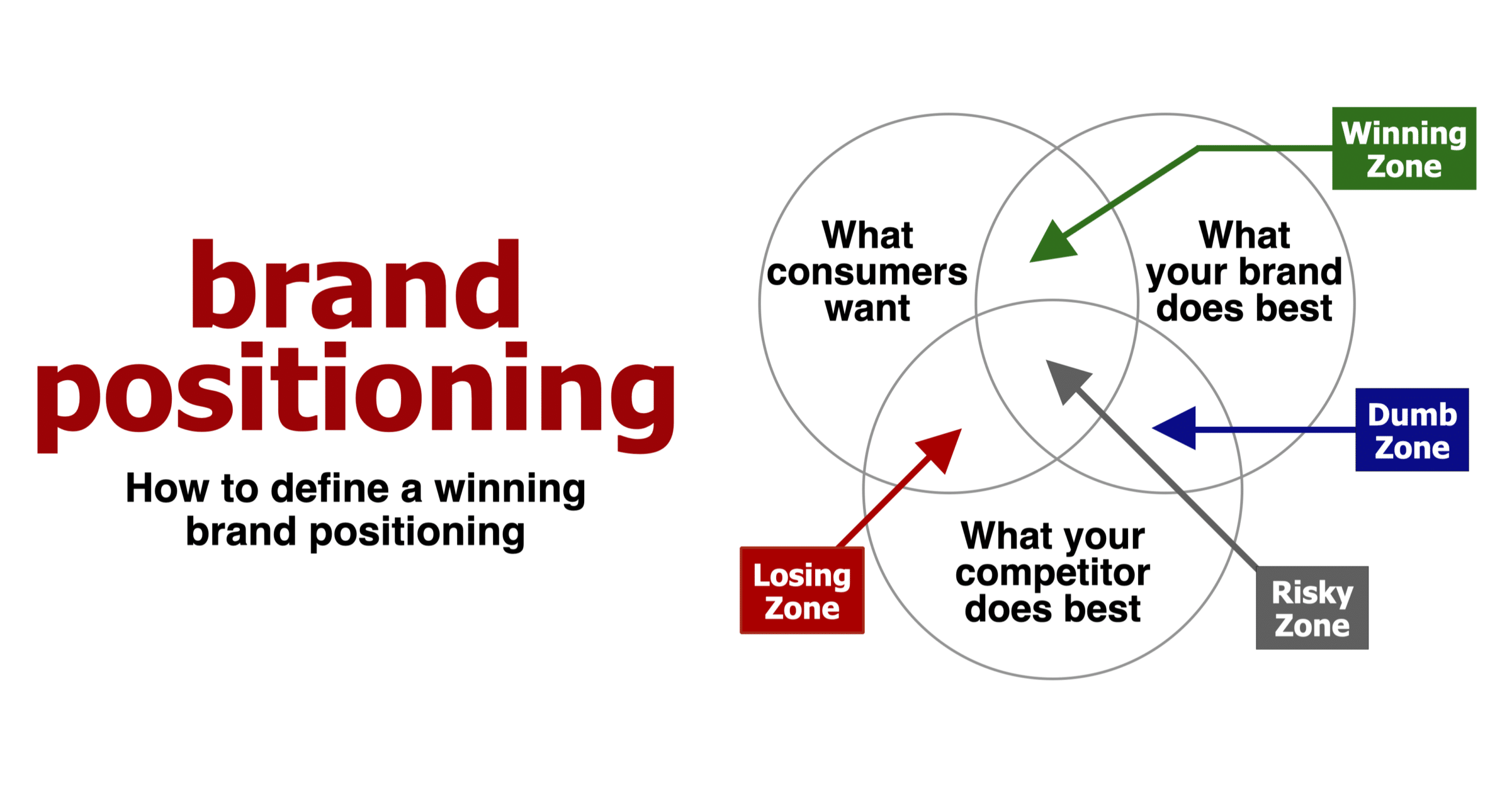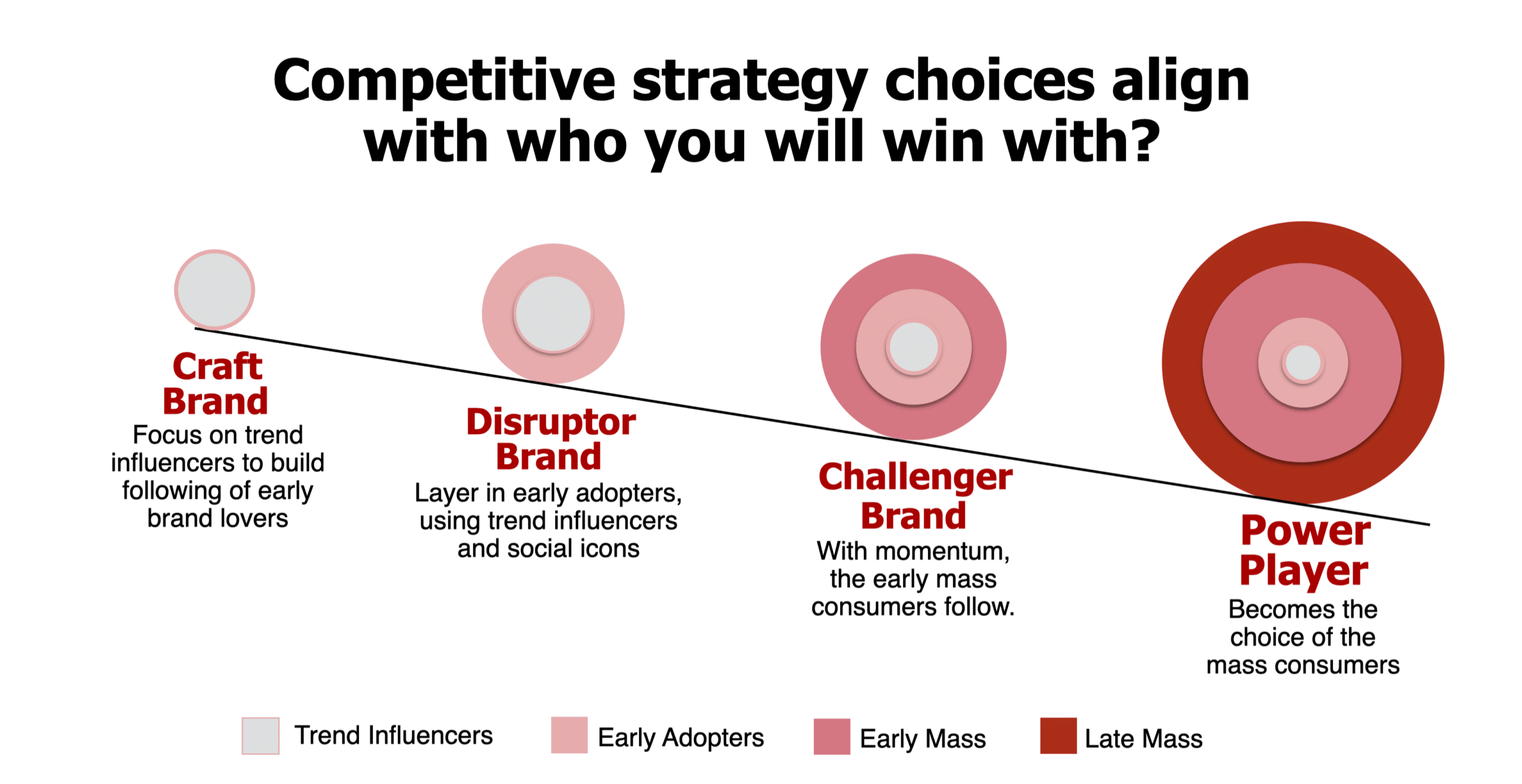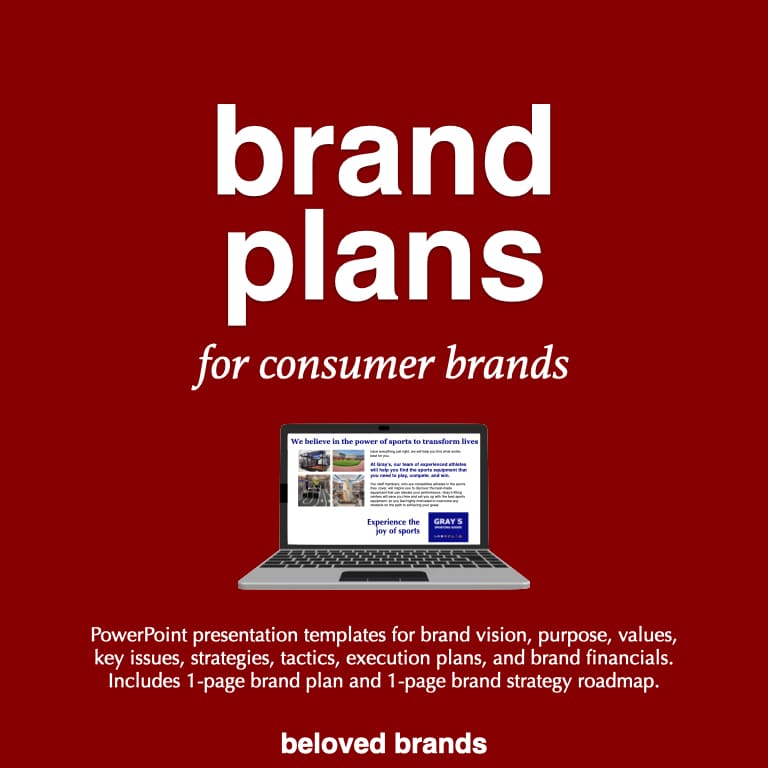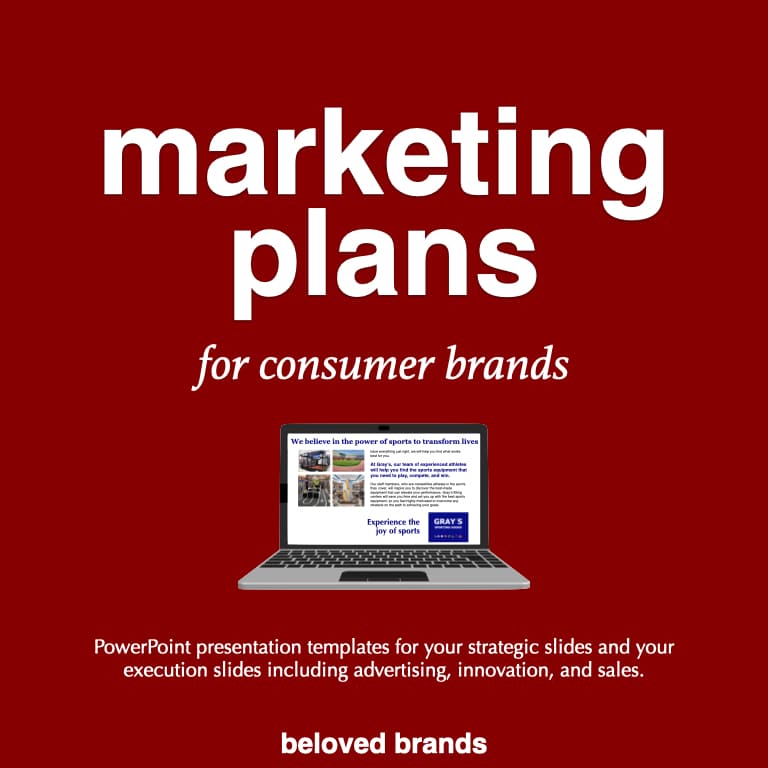When I was in business school, I learned about Michael Porter’s model as a way to understand the five forces that outline an industry attractiveness and competitive intensity. Porter’s Model a great starting point to get you to think more strategically and how you can win through power. However, I want to show you how brand leaders can go beyond Porter’s Model and start to see other sources of power, which reinforces our idea that the more loved a brand is by consumers, the more powerful and profitable that brand will be. I see brand love as a stored energy that can be used to drive further power and brand profit.
To illustrate, click to zoom in on our sources of brand power.
The 8 sources of Brand Power - Table of Contents
Brand Love
How tightly connected is your consumer to your brand?
I first came up with the idea of a brand love curve when I ran a marketing department with 15 different consumer brands, which exhibited various degrees of success. Honestly, it was hard for me to keep track of where each brand stood. Also, I did not want to apply a one-size-fits-all strategy to brands with dramatically different needs.
I could have used some traditional matrix with market share versus category growth rates or stuck with revenue size versus margin rates. Every day on the job, I noticed brands that had created a stronger bond with their consumer outperformed brands that lacked such a close connection. I started to refer to the high-performance brands as “beloved” because I could see how emotionally engaged consumers were with the brand.
At the other end of the scale, I referred to the inferior performance brands as “indifferent” because consumers did not care about them. They failed to stand for anything in the consumer’s mind; they were not better, different, or cheaper. I could see how these brands were unable to create any connection with their consumers – and they faced massive declines.
Beloved brands have it easier
Everything seemed to work better and easier for beloved brands. New product launches were more impactful because the brand’s loyal consumers were automatically curious about what was new. Retailers gave these the beloved brands preferential treatment because they knew their consumers wanted them. With a beloved brand, retailers knew their consumers would switch stores before they switch brands. Everyone in my organization, from the President to the technician in the lab, cared more about these beloved brands. No one seemed to care about the indifferent brands. Internal brainstorm sessions produced inspiring ideas on beloved brands, yet people would not even show up for brainstorms on indifferent brands.
I found that everyone wants to be part of a beloved brand
Our agencies bragged about the work they did on beloved brands. Even my people were more excited to work on these beloved brands, believing a move to the beloved brand was a big career move while being moved to an indifferent brand was a career death sentence.
These beloved brands had better performance results and better consumer tracking scores on advertising. They saw a stronger return on marketing investment, with a better response to marketing programs, higher growth rates, and higher margins. The overall profitability fuelled further investment into beloved brands.
To illustrate, click to zoom in on our brand love curve to focus your consumer strategy.
Brand Power
Brand love generates brand power
Establishing a deep emotional bond with customers is akin to supercharging Michael Porter’s Five Forces model with an amplifying emotional effect, transforming your brand into a dynamic power force in the marketplace. Brand love doesn’t just impact—it multiplies and accelerates its influence across all fronts, including consumers, competitors and new entrants, employees, influencers, media, suppliers, and channel partners. Think of brand love like compounding energy, where each positive interaction builds upon the last, creating a snowball effect that magnifies and energizes every aspect of your brand’s presence.
Power over buyers
A beloved brand has command power over consumers who love them, as consumers feel more and think less. These brand fans pay price premiums, line up in the rain, follow the brand as soon as it enters new categories, and relentlessly defend it from attackers. They cannot live without the brand.
Beloved brands have power over channel customers, who know their consumers would switch stores before they switch brands. Stores cannot stand up to the beloved brand; instead, they give the brand everything in negotiations. The beloved brand ends up with stronger store placement, better trade terms, and better promotions from retail partners. Retailers give Apple their own space, far away from competitive brands.
Power over substitutes and new entrants
The competitors, whether current competitors or new entries, cannot match the emotional bond the beloved brand has created with its brand fans. The beloved brand monopolizes emotions, making the consumer decisions less about the actual product and more about how the experience makes consumers feel. Unless a new brand has an overwhelming technological advantage, breaking the emotional bond the consumer has established with the beloved brand will be impossible.
Power over suppliers
Suppliers serve at the mercy of the beloved brand. The high volumes drive efficiencies of scale that drive down production costs, backing the supplier into a corner before they offer up most of those savings. Plus, the supplier becomes willing to use the beloved brand to sell their services to other potential brands.
Beloved brands have power over employees who want to be part of the brand. They are brand fans who are proud to work on the brand. They embody the culture on day one and want to help the brand succeed. The beloved brands have power over key influencers, whether they are doctors recommending a drug, restaurant critics giving a positive review, or salespeople at electronics shops pushing the beloved brands. These influencers become fans of the beloved brand and build their emotions into their recommendations.
Power over the media
The beloved brand has power over the media, whether paid, earned, social, or search media. With paid media, the beloved brand gets better placement at cheaper rates, and they are one of the first calls for possible brand integrations. The beloved brand is considered newsworthy, earning more free media via mainstream media, expert reviews, bloggers, and user-generated content.
Being famous, the beloved brand bypasses the need for search engine optimization (SEO). It becomes part of the conversation, whether through social media or at the lunch table at work. They use their homepage website to engage their most loyal users, inform the market of upcoming changes, allow consumers to design their version of their brand, and sell the product directly to brand lovers.
Impact on light buyers
Arguing about the degree of brand loyalty or the impact of light buyers feels tactical and needs to include the impact on profit. If I go to an Apple store 10 minutes before it opens, people will be standing around waiting to get in. They aren’t looking for price discounts. They come in with $2000 ready to buy and gladly pay $2500 for something cool they hear about. Apple brand fans keep buying the latest iPhone and follow Apple into the Apple Watch and AirPods. They now have Apple Car Play and Apple Pay. Apple’s retail store has the highest sales per square foot, twice that of the number two brand—Tiffany’s. Brand fans provide Apple with higher volumes at higher prices with fewer advertising dollars needed to reach them. That’s why Apple is valued at over $3 trillion.
Competitive Strategy
To find the competitive space in which your brand can win, I introduce the Venn diagram of competitive situations. Looking below, the first circle should list out everything the consumer wants. The second circle then lists everything your brand does best. And, finally, the third circle lists everything your competitor does best.
To illustrate, click to zoom in on our competitive strategy diagram.
The Venn diagram helps illustrate the conceptual thinking of brand positioning. We start with what consumers want, what your brand does best, and what your competitor does best. These three circles highlights our winning zone, losing zone, dumb zone, and risky zone.
To illustrate, click to zoom in on our competitive strategy diagram.
Regarding marketing war games, I will use this Venn diagram to map out four types of competitive strategy situations:
- Power players
- Challenger brands
- Disruptor brands
- Craft brands.
Brand Profitability
Brand love means brand profits
With all the love and power the beloved brand generates, it becomes easy to translate that stored power into sales growth, profit, and market valuation. Here are the eight ways a brand can drive profits:
- Premium pricing
- Trading up on price
- Lower cost of goods
- Lower sales and marketing costs
- Stealing competitive users
- Getting loyal users to use more
- Entering new markets
- Finding new uses for the brand.
Beloved brands can use higher prices and lower costs to drive higher margins
Most beloved brands can use loyal brand lovers to command a premium price, creating a relatively inelastic price. During negotiations, the weakened channel customers cave in to give the brand richer margins. Satisfied and loyal consumers will trade up to the next best model. A well-run beloved brand can use its high volume to drive efficiency, helping to achieve a lower cost of goods structure.
Not only can beloved brands use their growth to drive economies of scale, but suppliers will also cut their costs to be on the roster of the beloved brand. The beloved brand will operate with much more efficient marketing spend, using its power with the media to generate lower rates with plenty of free media. The higher sales volumes make the beloved brand’s spending ratios much more efficient. The consumer response to the marketing execution is much more efficient, giving the brand a higher return on investment.
Beloved brands use higher shares of a bigger market to drive higher volume
The beloved brands use their momentum to reach a tipping point of support to drive higher market shares. They can get loyal users to use more as consumers build the beloved brand into life’s routines and daily rituals.
It is easier for beloved brands to enter new categories, knowing their loyal consumers will follow. Finally, there are more opportunities for the beloved brand to find more uses to increase the number of ways the beloved brand can fit into the consumer’s life.
The more loved your brand is by consumers, the more powerful and profitable your brand will be.
Our brand toolkit for consumer brands is our most comprehensive template helps you communicate your brand plans, brand positioning, business review and creative briefs.
Our brand plan template offers slides for vision, purpose, analysis, key issues, strategies, and execution plans, ensuring a thorough approach to your brand’s development. The brand positioning template guides you through defining your target profile, crafting a brand positioning statement, and developing a unique brand idea, concept, values, story, credo, and creative brief. Finally, our business review template provides slides for in-depth analysis of the marketplace, customers, competitors, channels, and your brand.
Choose the right template for your business needs
Marketing Plans for consumer brands
Combining strategic slides for insightful planning and marketing execution slides for seamless implementation, our templates are designed to propel your brand towards success and help you make a lasting impact in the market.


